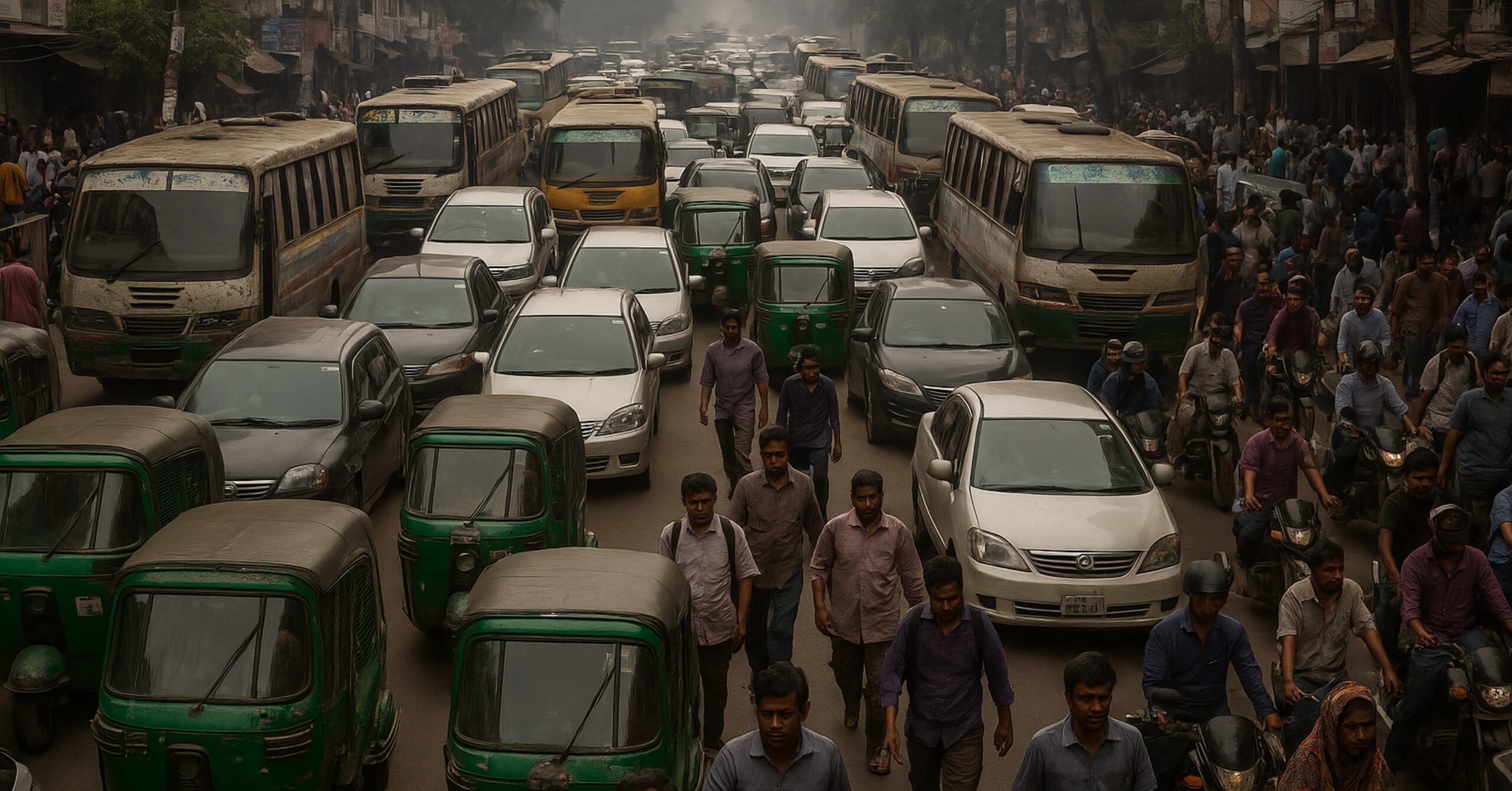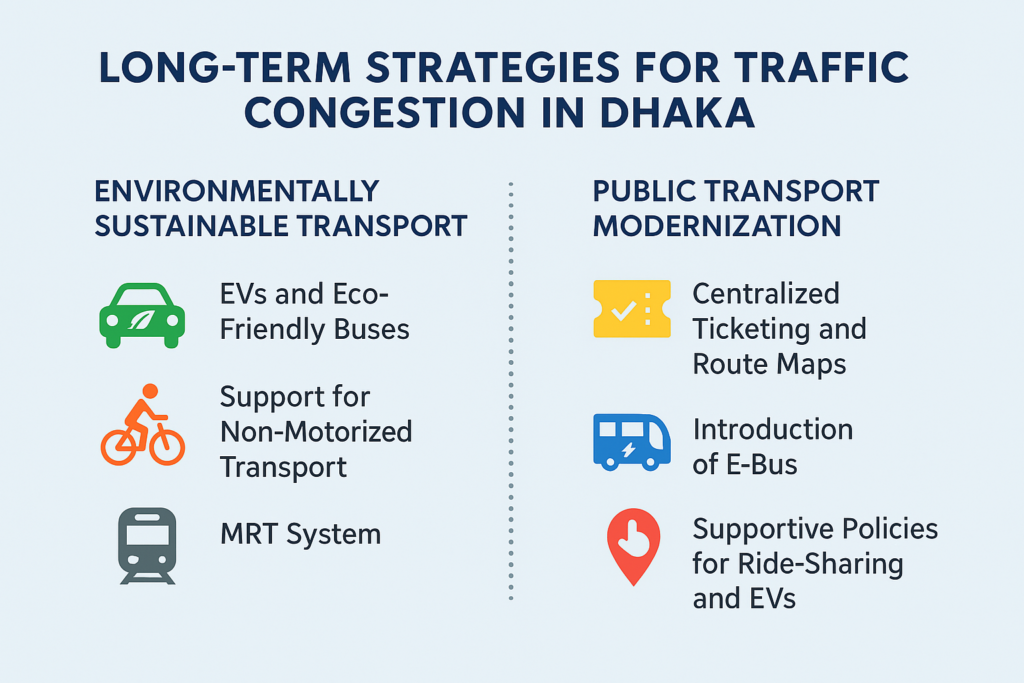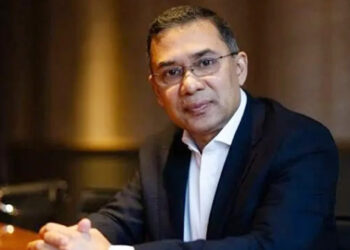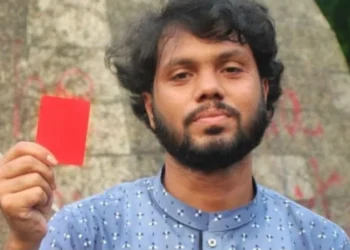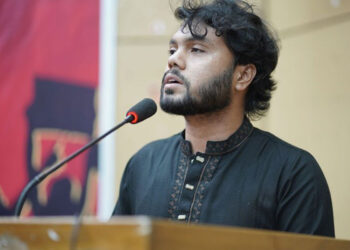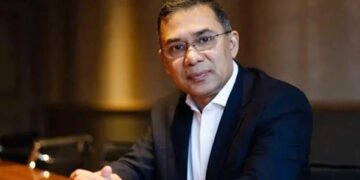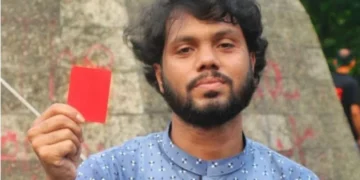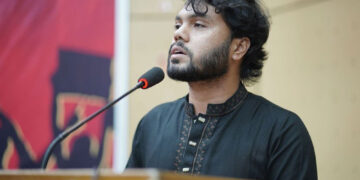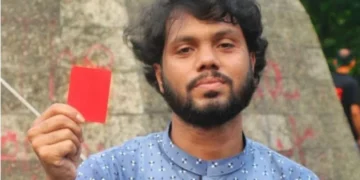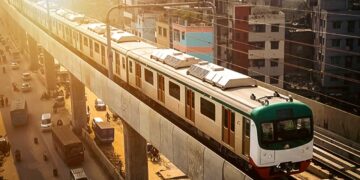Bangladesh’s traffic congestion has long been a major source of misery, particularly in Dhaka, but it has recently become much, much worse. When the total 246 cities of the world are considered, Dhaka was found to be the seventh most traffic jam prone city (World Traffic Index, 2022). While the top cities on the list are in developed countries, places that rank high for traffic congestion include Los Angeles in the United States, as well as Delhi, Kolkata and Sharjah in the United Arab Emirates. As BUET Accident Research Institute (2020) found,the daily traffic jams waste over 19 million working hours, costing the country 6–10% of its GDP annually. The congestion also adversely affects the physical and emotional health of the people and increases environmental degradation.
Background of Traffic Congestion
With a population of over 10 million, Dhaka has one of the fastest-growing populations , increasing 50% expansion from 1995 to 2005. Sectoral expansion has also led to a 134% increase in traffic congestion. The city, which boasts half the nation’s employment and 20% of its GDP, is the country’s hub of education, government, health care and business. As the population has increased, so has traffic as a result. Average traffic speed in the city has fallen from 21 km/h a decade ago to under 7 km/h at present; under these conditions, average traffic speed in Dhaka is set to touch 4 km/h by 2023. But main arteries such as Bishwa Road; Mohakhali-Tejgaon; Panthapath-Bijoy Sarani; and Hatirpool are especially congested, underscoring the immense pressure on the capital’s infrastructure.
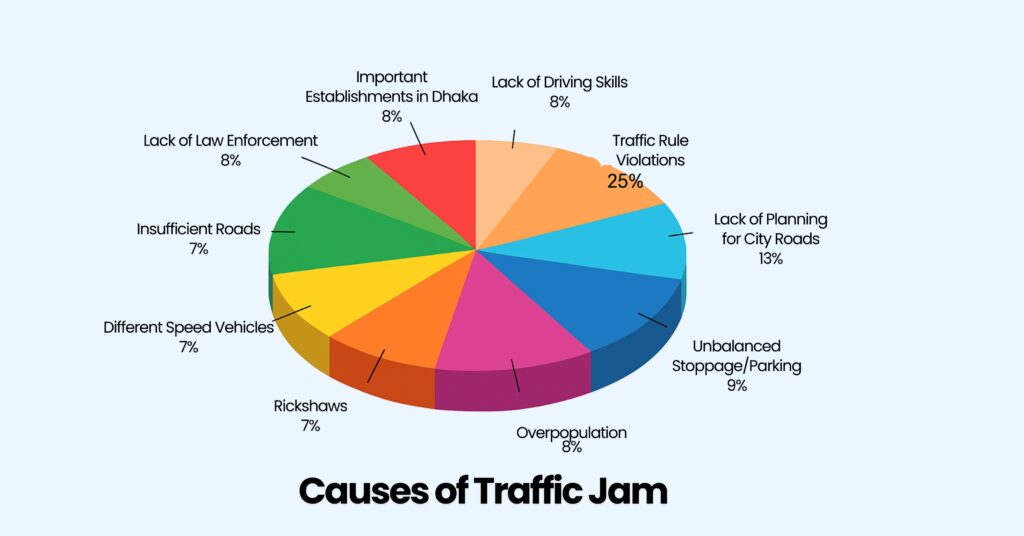
Traffic Congestion in Dhaka (2024-2025)
In (2024-2025), a major traffic congestion incident occurred in Dhaka and its nearby areas. Here are some notable scenario:
Highway Rallies for Political Purpose: Dhamrai – A rally of the Bangladesh Nationalist Party (BNP) on the Dhaka-Aricha Highway created a huge traffic jam on February 24, 2025. The party leaders and activists joined the event, in which the traffic jam stretched some 7-8 kilometers, from Nayarhat to Kalampur. The incident highlights how large political events can frustrate important transportation hubs. Dhaka Tribune
Road Accidents Causing Extended Delays: On Jan 13,2025, a 13-kilometre-long tailback was created in the Dhaka-Chattagram Highway near Gazaria Munshiganj. The traffic was caused by a road crash and the breakdown of another car. The situation started around 7:00 AM and led to major delays for workaholics, highway police sold. TBS News
Eid Travel Challenges: In March 2025, road congestion on the Dhaka-northern districts route, one of the busiest routes in the country, soared during holidays including Eid-ul-Fitr. Travel times on this road increased by 10 to 12 hours, with buses leaving Dhaka being stuck for hours at the Baipail and the Chandra crossings. The 13-km-stretch from Baipail to Chandra took over two hours for vehicles to cover, showing the type of infrastructure challenges those face during rush hour. Dhaka Tribune
Effect of Public Demonstrations: (From Nov 21, 2024) The rickshaw drivers protesting against the ban on battery-powered rickshaws on the road in Dhaka protested and blocked several roads, which caused severe traffic congestion and public inconvenience. Protests on city major roads started at in between: 9:30 AM and 10:00 AM and this has caused a huge disruption to traffic in city. Jagonews24
Weather-Induced Traffic Disruptions: Dense fog caused a series of accidents on the Dhaka-Chattagram Highway in January 2025 creating a 14-kilometre long traffic snarl. Decreased visibility meant there were only two lanes of moving vehicles instead of the usual four, compounding the jam. Commuters said it took them as long as five hours to travel only 10 kilometers (six miles) on the highway.
These incidents from 2025 illustrate the multifaceted causes of traffic congestion in Dhaka, including political events, road accidents, holiday travel surges, adverse weather conditions, and public protests.
2025 Situation: Recent Data & Observations
Traffic is still a persisting problem in Dhaka Bangladesh affecting the daily life. New research and documents from 2024 and early 2025 discuss the complex reasons and the consequences of this challenge.
Economic Impact:
- Annual Loss: Traffic jams cost Bangladesh nearly $6.5 billion every year, approximately 11% of the state budget according to Daily Observer. The impact of this congestion can lead to a significant loss in the economy. But current trends would put the economic cost at $11.4 billion annually by 2035, according to experts.
- Daily Loss: Approximately $160 million is lost every day in the country owing to traffic congestion. Daily Observer.
- Fuel Crisis: The lack of traffic management causes 40% more fuel consumption than the average in Dhaka, costing $483,872 a day in a loss of funds. New Age.
Infrastructural Impact: Already belated infrastructure projects, like the Dhaka-Narayanganj Link Road extension, are delayed, worsening the already bad traffic situation. The project was extended until June 2024 but remains uncompleted. Traffic speed on Dhaka’s streets has declined sharply in a decade. As per a report by the World Bank, average speed fell from 21 km/h a decade back to 7 km/h today and is projected to dip to 4 km/h by 2035, slower than a standard person walk speed.
Social and Political Factors: Public transport services are disrupted due to labour strikes, one by railway workers who went on strike in January 2025 over pension benefits. More and more people used road transport, which clogged up city streets. The strike led to the cancellation of trains across the country, affecting tens of thousands of passengers and highlighting the fragility of the nation’s transport infrastructure.
Read More: Dubotech: Transforming Underwater Technology in Bangladesh
Health and Environmental Impact: Commuters spend an average of 276 hours stuck in traffic a year, contributing to higher stress and health problems. Emissions , Particularly from vehicles , Account for 77% of the air pollution in the greater area and 70% of residents suffer from respiratory issues. New Age
Short-Term Solutions to Address Traffic Congestion
There are some temporary solutions to mitigate traffic congestion in Dhaka. It is used these strategies to optimize the traffic flow, decrease the dependence on private vehicles and improve city transportation infrastructure. Here are the key solutions:
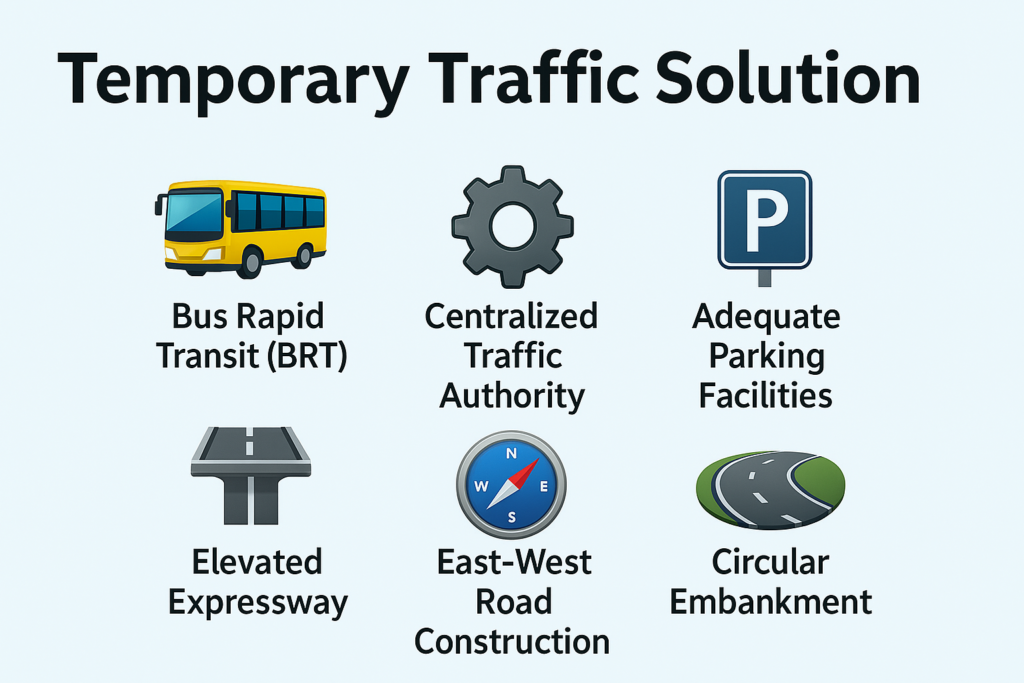
Bus Rapid Transit (BRT): Introduce a dedicated bus lane for public buses to reduce road congestion.Passenger transport in cities remained largely dependent on private vehicles; however, BRT systems also emerged as a better, cheaper, and more efficient transport in them. The idea is to “bring many buses and many stations and make it attractive and comfortable for citizens.
Elevated Express Highway: Build a lift road to avoid congested streets and promote vehicle movement in the city. This is especially important, since there isn’t much space to widen existing roads because of adjacent buildings and infrastructure surrounding the roads.
Centralized Traffic Authority: Create one authority to manage traffic and develop traffic laws in Dhaka. There are also transaction delays as the traffic is controlled by multiple centralized organizations.
East-West Road Construction: Although Dhaka is contiguous in North-South direction from Luxmibazar to Kathalbagan, where there exists an abundance of roads, the East-West is missing which can as well play a vital role in connecting major thoroughfare in the upcoming days. The move would help divert traffic more evenly throughout the city and open up alternative pathways.
Adequate Parking Facilities:7% of the city area (compared to 25% ideal parking area) the availability of parking spaces should increase. To stop the disorderliness, you have to stop parking unauthorized — now the parked cars are also blocking the road and causing more traffic.
Circular Embankment-Cum-Road: Connect the Western and Eastern embankment of Dhaka to form a circular road round the Dhaka. This road mainly intends to act as a by-pass and thereby reduce the traffic load on the city center.
Bridging the Gap in Missing Links of the Road: Filling in gaps in the road network by connecting missing links between arterial roads. This would decrease travel time, improve access on the roads and provide better traffic circulation overall.
The aim is that by using these short-term solutions will help Dhaka to reduce traffic congestion and lead towards a sustainable transport system which will be more effective for the increased population.
Long-Term Strategies for Traffic Congestion in Dhaka
Here are some sustainable, efficient, and well-planned strategies to reduce traffic jam . Key proposals include:
Environmentally Sustainable Transport: Dhaka needs a sustainable transport solution. The transport sector is important for city development but has caused enormous environmental problems like air pollution and high carbon emissions. The innovative transport systems of the future will seek to optimize mobility while minimizing their negative impact on the environment.
- EVs promoting green, but also eco-friendly buses
- Building on the success of replacing high-polluting two-stroke engine auto-rickshaws with CNG (compressed natural gas) versions, which has already helped reduce emissions in Dhaka.
- To support non-motorized transport like walking and cycling, particularly as Dhaka has a long history of using rickshaws that provide an eco-friendly means of transport.
MRT System (Mass Rapid Transit Train):The Bus Rapid Transit (BRT) system has its own merits, but it cannot be the ultimate solution for Dhaka, particularly with the city’s population growing rapidly. The transportation needs of city residents cannot efficiently be served by a more expansive and dependent, system.
- Hybrid transport solutions :A combination of BRT with Metro rail (MRT) will offer improved capacity and coverage as compared to scenarios relying only on BRT. In the coming decades, with the city’s population surpassing 36 million, BRT capacity will not be enough.
- Prioritization of Metro System: MRT system, high-capacity, fast, reliable public transport. It can reduce traffic load on congested roads and provide an alternative mode of transport.
- Traffic Management: Maximizing Existing Infrastructure: To start with, Dhaka’s traffic situation will improve if its existing infrastructure is not just built but also managed efficiently. But a comprehensive MRT system must be part of the long-term solution.
Grade-Separated Road Network: Dhaka now lacks a road network that can accommodate the flow of traffic from its population. Experts propose that a Grade-Separated Road Network be introduced — this would ultimately create different stages of the path of transportation directing toward its end goal, thereby reducing congestion and traffic.
- Flyovers or Elevated Highways: The construction of flyovers or elevated highways, will prevent vehicles from entering congested areas reducing travel time and easing the traffic flow. Running through the city with fewer points to stop on means less waiting time to cross the city during peak hours.
- Underground Roads (Subways): In an ordinary way, the road network should be again improved. These can cut down traffic on ground-level roads and use precious space more effectively.
- Justification of Conventional Roads: Another way is that the current road infrastructure can broaden and upgrade the thoroughfares by fortifying intersections, to avoid bottlenecks. Multi-lane highways construction and lanes for buses and emergency vehicles dedicated would also allow the space of roads to be optimized.
Public Transport Modernization in Dhaka
For Dhaka to overcome its traffic and environmental challenges, a modernized public transport system is a must. There are several initiatives that experts say could make public transit in the city more efficient, accessible and sustainable. The components for public transport modernization are the following:
Centralized Ticketing and Route Maps: An optimized and easy to use public transport system is essential for alleviating congestion and persuading people to use public transport rather than their cars.
- Unified Ticketing System: A universal, digital ticketing system across all public transportation (buses, metro, and water taxis). A single card or mobile app that integrated all forms of transport would enable easy transfer between buses, trains and metro systems without needing to go through multiple ticketing systems with each journey.
- Route Maps and Information Systems: All transport must publish clear, user-friendly route maps in all stations, on buses, and on websites. Interactive maps and real-time tracking apps can help passengers plan out more efficient routes to avoid delays.Because this will create a more centralized front for public transport, the tendency will be a lot smoother and fuller to use it, in order to lessen the use of private transport.
Introduction of E-bus and Environmental Impact: The introduction of electric buses (e-buses) in Dhaka’s public transport system is one of the key solutions that can help tackle both traffic congestion and environmental pollution. E-buses offer a cleaner, more sustainable alternative to traditional diesel busing that can reduce air pollution and improve the city’s overall air quality.
- Reduced Emissions — E-buses are zero-emission vehicles as compared to conventional vehicle buses powered by fossil fuels. This helps in carbon emissions reduction and cutting air pollution, a major health problem in Dhaka.
- Reduced Operating Costs: While e-buses come with higher initial purchase prices, they require less maintenance and minimize fuel consumption, leading to reduced operating costs over time. Long Run – Public transport is more cost effective.
- Low Noise: E-buses are a lot quieter than conventional buses, resulting in reduced noise pollution, especially in high-density sections of towns.
- Waste Reduction: Battery-powered buses are a vital component in the complete strategic approach to waste reduction as this contributes to sustainability goals.
Supportive policies for ride-sharing and electric vehicles: Fleets of these vehicles should be incentivised too as part of the broader sustainable transport push, and the government should also provide policies to promote ride-sharing services as well as electric vehicles (EVs) in any upcoming budget.
- Promoting Ride Sharing: Platforms such as Uber, Pathao, etc. should be included in integrated public transport system. Implementing government incentives like tax rebates or reduced fees for such services can also help to stimulate demand for ride-sharing, resulting in drivers swapping out their private vehicles for a ride-sharing option as the use of public transportation or ride-sharing services can reduce congestion.
- Developing E-Mobility: Creating incentive for EV based on both personal and commercial vehicle That can include everything from tax breaks to subsidies on EV purchases to the construction of an EV-charging network throughout the city.
Conclusion
Dhaka the densely populated, much overpopulated capital of Bangladesh is afflicted with a chronic toxicouse traffic jam and has become the highest traffic congested road in the world. Traffic is slower and more erratic and crippling economic losses continue, the problem is getting worse. As we know, without proper strategy and coordination the bills will keep on piling up.
Solutions like sustainable transport, better traffic management and infrastructure improvements hold promise for Dhaka. Mitigating traffic congestion will require a concerted, collaborative effort from government agencies, urban planners, and the public to make Edmonton a more efficient, sustainable, and livable city. Collective effort will lift up Dhaka to overcome these issues and shape a better tomorrow.
References
Share via:

